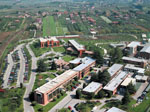Italy Spreads Its Defense, Aerospace Resources
 |
| Located 20 kilometers south of Rome, the European Space Agency’s (ESA’s) Centre for Earth Observation (ESRIN) collects data from orbiting Earth science satellites. The facility also supports a variety of ESA research efforts. The ESRIN’s other mission is to interact with commercial and government users to help develop new space-related products and services to help European and Italian innovation and competitiveness. |
One of
Traditionally, manufacturing and scientific research centers were concentrated in
Gen. Finocchio explains that these growth policies begin by identifying local areas of expertise in business and technology. This selection process can be top-down or bottom-up and it is either launched through a centralized quantitative analysis study at the national level or a local public request for proposals. In the case of an open public process, international standards are followed that encourage the participation of Italian and international representatives from business and academia.
The Italian government has designated these new regional growth areas as technology districts and has established guidelines to foster economic and scientific growth and competition at the local level.
Northwest Italy includes heavy industry and aerospace facilities in the
The Lazio, Abruzzo and
The Italian government has also developed the Joint Experimental and
While the government has taken steps to distribute high technology enterprises, the regions retain their strengths.
A variety of national and international research centers also are located around the capital. The town of
One of the programs supported by the ESRIN is the Vega Program, the ESA’s effort to develop a rocket capable of launching small satellites. Other work includes developing and supporting ESA software and information systems, a telecommunications laboratory, and housing the European Centre for Space Records. The center also hosts the ESA Web portal and a virtual reality theater that provides specialists and students with visual representations of complex Earth observation and geographic data.
Another important area in the region is the
New Systems Face Uncertain Funding Environment To meet its modernization goals, the Italian Ministry of Defense has launched a number of development projects in areas such as soldier modernization, space and satellite communications, software-defined radios, radar and unmanned aerial vehicles (UAVs). However, a lack of financial resources is delaying the development and deployment of these systems. “ Delayed programs affect the operation of the country’s armed forces. The few remaining free funds in the defense budget are competing with existing capital projects such as warships, missiles, the Eurofighter and international commitments such as participating in the Joint Strike Fighter program. These large-platform purchases leave fewer funds for network-centric projects than originally planned, Mucciolo says. The lack of funding is also affecting For example, Finmeccanica is part of an international consortium to develop a software-defined radio. Mucciolo notes that the need for a software-defined radio has become an urgent operational requirement for many European nations, adding that there is ongoing work to develop a European waveform to ensure interoperability. But he admits that Despite the grim outlook, Italian firms are moving ahead in two areas, UAV and radar system development. National UAV research is divided between two Finmeccanica companies, Alenia and Galileo. Alenia produces medium-sized and larger aircraft, while Galileo develops and manufactures small tactical UAVs. A nationally-produced UAV is important because The Italian Ministry of Defense also has realized that it is operationally useful to develop tactical UAVs. The Falco platform was developed for the Italian military, but funding issues have prevented immediate acquisition. Instead the first sales have been to Two other locally developed medium-altitude, long-endurance UAV platforms are the Sky-X and Sky-Y programs. Sky-X is Italian ground forces also lack mini UAVs such as the hand-launched Raven used by Radar systems are another bright spot for Italian electronics firms and their international partners. One example is the Empar G-band, multifunction, active phased array radar being developed for the Italian and French navies. The system’s antenna rotates at 60 times a minute to provide tracking, surveillance and weapons fire control capabilities. The radar is designed to operate in highly cluttered conditions and to resist jamming. Empar allows warships to counter a range of airborne threats such as supersonic aircraft, sea-skimming missiles, supersonic missiles, helicopters and UAVs. The radar system is being integrated on the Horizon frigates entering service with the Italian and French navies and |
AFCEA’S Italian Chapters Grow, Adapt Two key association chapters are deeply involved with AFCEA’S While the focus of |




Comments